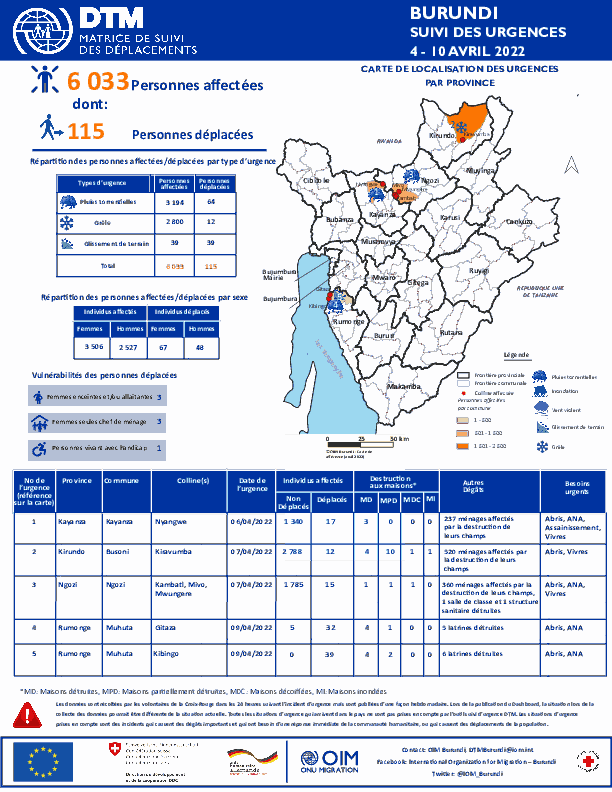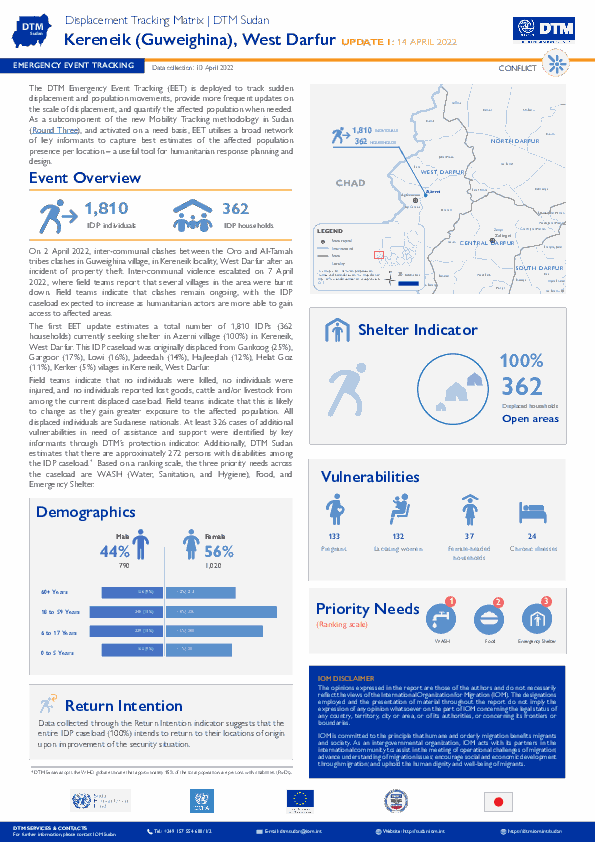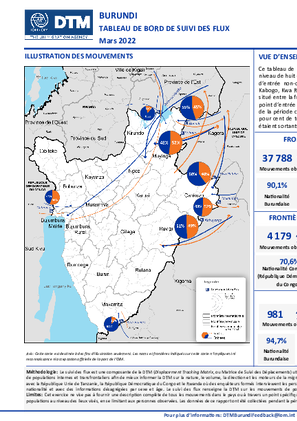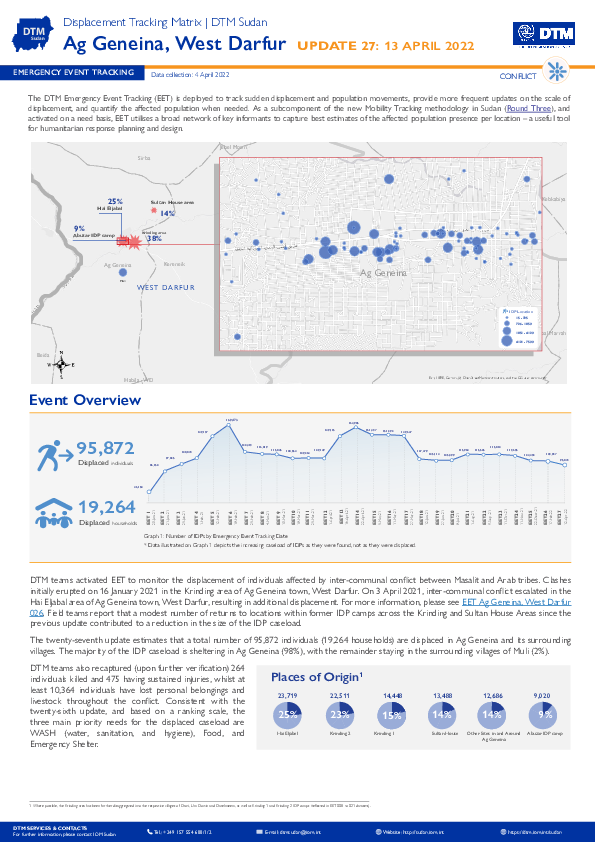-
Countries
-
Data and Analysis
-
Special Focus
-
Crisis Responses

Contact
DTM Burundi, DTMBurundi@iom.int
Language
English
Location
Burundi
Period Covered
Apr 04 2022
Apr 10 2022
Activity
- Event Tracking
- Mobility Tracking
Entre le 4 Avril et le 10 Avril 2022, la DTM a identifié 6 033 personnes affectées, dont 115 personnes déplacées, par les pluies torrentielles, grêle, et glissement de terrain dans les provinces de Kayanza, Kirundo, Ngozi et Rumonge.

Contact
DTM Sudan; dtmsudan@iom.int
Language
English
Location
Sudan
Period Covered
Apr 10 2022
Apr 14 2022
Activity
- Event Tracking
The DTM Emergency Event Tracking (EET) is deployed to track sudden displacement and population movements, provide more frequent updates on the scale of displacement, and quantify the affected population when needed. As a subcomponent of the new Mobility Tracking methodology in Sudan (Round Three), and activated on a need basis, EET utilises a broad network of key informants to capture best estimates of the affected population presence per location – a useful tool for humanitarian response planning and design.

Contact
DTMBurundi@iom.int
Language
English
Location
Burundi
Period Covered
Mar 01 2022
Mar 31 2022
Activity
- Flow Monitoring Survey
- Flow Monitoring
Ce tableau de bord fournit une analyse des tendances de la mobilité des populations observées au niveau de huit (8) points de suivi des flux (Flow Monitoring Points, FMP), six (6) établis sur des points d’entrée non-officiels établis entre la frontière du Burundi et la République Unie de Tanzanie à Kabogo, Kwa Rutuku, Mbundi, Kabuyenge, Mukambati et Kwa Buhinja; un (1) point d’entrée officiel situé entre la frontière du Burundi et de la République Démocratique du Congo à Gatumba et un (1) point d’entrée officiel situé entre la frontière du Burundi et du Rwanda à Gasenyi-Nemba. Au cours de la période considérée, un total de 42 948 mouvements ont été observés à ces points. Environ 55 pour cent de tous les mouvements au niveau des trois frontières étaient entrants et 45 pour cent étaient sortants.
Contact
DTM Libya, DTMLibya@iom.int
Language
English
Location
Libya
Snapshot Date
Mar 31 2022
Activity
- Site Assessment
- Mobility Tracking
Detention Centre Profiling is a component of IOM Libya’s Displacement Matrix programme. It is a data oriented tool that routinely provides specific sex and age demographic data and key sectorial information on individuals held in Libya’s detention centres on the date of assessment.

Contact
DTM Yemen, iomyemendtm@iom.int
Language
English
Location
Yemen
Period Covered
Mar 01 2022
Mar 31 2022
Activity
- Points of Entry (PoE)
HIGHLIGHTS (From 1 to 31 March 2022)
• 34 new cases – 9 new deaths | source: WHO
• Updates on numbers of new cases in areas controlled by the De Facto Authorities (DFA) based in Sana’a are not available.
• 5,354 non-Yemeni migrants arrived at the Yemeni southern governorates of Lahj and Shabwah and 7,607 Yemeni returnees arrived in Yemen from Kingdom of Saudi Arabia (KSA). (Please see March FMR report for more details).
• No IDP households (HH) reported COVID-19 as the reason of displacement. So far, the total number of IDP HHs who have cited COVID-19 as the primary reason for displacement is 1,559 households.
• The authorities of Al Wadeeah land border between Yemen and Saudi Arabia announced the lifting of COVID-19- travel restrictions. Travelers can now cross Al Wadeeah land border without providing PCR tests or proof of vaccinations.
• In early March, the Saudi Arabian government lifted all COVID-19-related entry restrictions. Visitors to KSA no longer need to present proof of vaccination or a PCR test to enter the country, and quarantine requirements have been removed.

Contact
DTM Europe, DTMMediterranean@iom.int
Language
English
Location
Slovakia
Period Covered
Mar 09 2022
Mar 30 2022
Activity
- Survey
- Return Intention
Since 24 February 2022, an increasing number of Ukrainian refugees and third-country nationals (TCNs) entering Slovakia has been registered as a result of the war in Ukraine. As of 13 April 2022, Slovak authorities have reported 326,997 arrivals from Ukraine, out of whom 301,772 were Ukrainian refugees and 12,817 TCNs.
This report is based on a displacement patterns, needs and intentions survey launched by IOM’s Displacement Tracking Matrix
(DTM). Surveys are conducted face-to-face by trained enumerators with Ukrainian refugees and TCNs fleeing Ukraine after 24
February 2022. This report presents a rapid sectoral needs analysis based on 161 surveys with Ukrainian refugees and TCNs
collected between 9 and 30 March 2022.

Contact
DTM Turkey, dtmturkey@iom.int
Language
English
Location
Republic of Türkiye
Period Covered
Jan 01 2022
Mar 31 2022
Activity
- Flow Monitoring Survey
- Flow Monitoring
- Migrants presence
According to the latest available figures from the Turkish Presidency of Migration Management (PMM), there are more than 5* million foreign nationals present in Turkish territory, 3.7* million of whom are seeking international protection. Most are Syrians (3,763,565* individuals) who are granted temporary protection status. In addition, international protection applicants from countries including Afghanistan, the Islamic Republic of Iran and Iraq constitute another group of foreign nationals. According to PMM, there were 29,256* international protection applicants present in Turkey in 20211, published annually. Moreover, according to UNHCR**, there are close to 330,000 international protection status holders and asylum-seekers. Since December 2021 the number of Syrians residing in camps has decreased by 687.
*Data source PMM, 31.03.2022
**Data source UNHCR, December 2021

Contact
DTM Sudan; dtmsudan@iom.int
Language
English
Location
Sudan
Snapshot Date
Apr 04 2022
Activity
- Event Tracking
- Mobility Tracking
The DTM Emergency Event Tracking (EET) is deployed to track sudden displacement and population movements, provide more frequent updates on the scale of displacement, and quantify the affected population when needed. As a subcomponent of the new Mobility Tracking methodology in Sudan (Round Three), and activated on a need basis, EET utilises a broad network of key informants to capture best estimates of the affected population presence per location – a useful tool for humanitarian response planning and design.
Contact
DTM Burundi, DTMBurundi@iom.int
Location
Burundi
Activity
- Mobility Tracking
- Baseline Assessment
Period Covered
Jan 31 2022 -Feb 18 2022
A baseline assessment is a sub-component of mobility tracking. It aims to collect data on IDP, migrant or returnee population presence in a defined administrative area of the country.
Population Groups
Survey Methodology
Unit of Analysis Or Observation
Type of Survey or Assessment
Keywords
Geographical Scope
Administrative boundaries with available data
The current dataset covers the following administrative boundaries
Contact
DTM Yemen, iomyemendtm@iom.int
Location
Yemen
Activity
- Event Tracking
- Mobility Tracking
Period Covered
Jan 01 2022 -Mar 31 2022
IOM Yemen DTM’s Rapid Displacement Tracking (RDT) tool collects data on estimated numbers of
households forced to _ee on a daily basis from their locations of habitual residence or displacement,
allowing for regular reporting of new displacements1 in terms of estimated numbers, causes of
displacement, geography and needs. It also tracks returnees who returned to their location of
habitual residence.
During the reporting period, between 1 January and 31 March 2022, IOM Yemen DTM tracked a cumulative 4,950 households (HHs) (approximately 29,700 individuals2) that experienced displacement at least once. Since the beginning of the year, the number of tracked new instances of displacement has been declining steadily. Safety and security concerns as a result of the con_ict were the main reason for displacement, accounting for 99 per cent (14,245 HHs) of the total, followed by economic reasons related to con_ict, accounting for one per cent (194 HHs). The majority of people moved into/within the following governorates and districts: • Al Hodeidah (1461 HHs) – Hays (1248 HHs), Al Khukhah (213 HHs) districts. Most displacements in the governorate originated from Al Hodeidah and Taiz. • Marib (1019 HHs) – Marib City (668 HHs), Marib (217 HHs), Harib (134 HHs) districts. Most displacements in the governorate originated from Marib and Al Jawf. • Shabwah (814 HHs) – Ataq (266 HHs), Osaylan (240 HHs), Ayn (145 HHs) districts. Most displacements in the governorate originated from Shabwah and Marib.
During the reporting period, between 1 January and 31 March 2022, IOM Yemen DTM tracked a cumulative 4,950 households (HHs) (approximately 29,700 individuals2) that experienced displacement at least once. Since the beginning of the year, the number of tracked new instances of displacement has been declining steadily. Safety and security concerns as a result of the con_ict were the main reason for displacement, accounting for 99 per cent (14,245 HHs) of the total, followed by economic reasons related to con_ict, accounting for one per cent (194 HHs). The majority of people moved into/within the following governorates and districts: • Al Hodeidah (1461 HHs) – Hays (1248 HHs), Al Khukhah (213 HHs) districts. Most displacements in the governorate originated from Al Hodeidah and Taiz. • Marib (1019 HHs) – Marib City (668 HHs), Marib (217 HHs), Harib (134 HHs) districts. Most displacements in the governorate originated from Marib and Al Jawf. • Shabwah (814 HHs) – Ataq (266 HHs), Osaylan (240 HHs), Ayn (145 HHs) districts. Most displacements in the governorate originated from Shabwah and Marib.
Population Groups
Survey Methodology
Unit of Analysis Or Observation
Type of Survey or Assessment
Keywords
Geographical Scope
Administrative boundaries with available data
The current dataset covers the following administrative boundaries